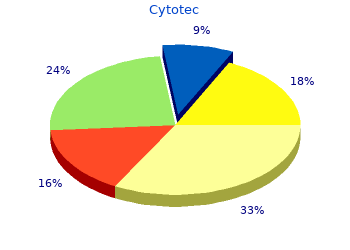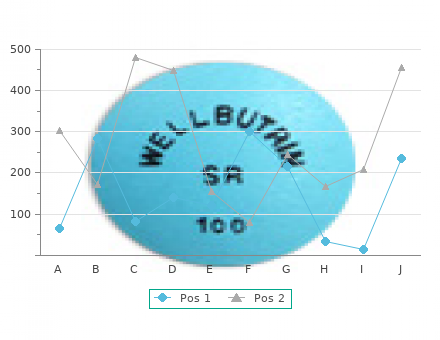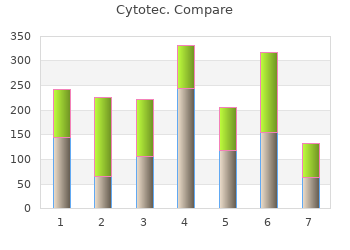Cytotec
2018, West Virginia University Parkersburg, Ernesto's review: "Cytotec generic (Misoprostol) 200 mcg, 100 mcg. Only $1,45 per pill. Order cheap Cytotec online.".
During periods when the availability of penicillin is com- promised proven 200 mcg cytotec, the following is recommended (see http://www. All seroreactive infants (or infants whose mothers were 1. For infants with clinical evidence of congenital syphilis seroreactive at delivery) should receive careful follow-up (Scenario 1), check local sources for aqueous crystalline examinations and serologic testing (i. If IV penicillin G is every 2–3 months until the test becomes nonreactive or the limited, substitute some or all daily doses with procaine titer has decreased fourfold. Nontreponemal antibody titers penicillin G (50,000 U/kg/dose IM a day in a single daily should decline by age 3 months and should be nonreactive dose for 10 days). Te serologic with careful clinical and serologic follow-up. Ceftriaxone must response after therapy might be slower for infants treated after be used with caution in infants with jaundice. If these titers are stable or increase after ≥30 days, use 75 mg/kg IV/IM a day in a single daily dose age 6–12 months, the child should be evaluated (e. For older infants, the dose should be enteral penicillin G. Terefore, ceftriaxone should be used in consultation who have had a severe reaction to penicillin stop expressing pen- with a specialist in the treatment of infants with congenital icillin-specifc IgE (238,239). Management may include a repeat CSF examination safely with penicillin. Penicillin skin testing with the major and at age 6 months if the initial examination was abnormal. For infants without any clinical evidence of infection at high risk for penicillin reactions (238,239). Although these (Scenario 2 and Scenario 3), use reagents are easily generated and have been available for more a. Manufacturers are working to ensure ceftriaxone is inadequate therapy. For premature infants who have no other clinical evidence accompanying minor determinant mixture. Skin-test–positive patients should be desensitized Evidence is insufcient to determine whether infants who before initiating treatment. Patients who have positive test results should be desensitized. One approach suggests that persons Management of Persons Who with a history of allergy who have negative test results should be regarded as possibly allergic and desensitized. Another Have a History of Penicillin Allergy approach in those with negative skin-test results involves test- No proven alternatives to penicillin are available for treating dosing gradually with oral penicillin in a monitored setting in neurosyphilis, congenital syphilis, or syphilis in pregnant women. Penicillin also is recommended for use, whenever possible, in If the major determinant (Pre-Pen) is not available for skin HIV-infected patients. In patients with reactions not likely to be IgE-mediated, or hypotension). Readministration of penicillin to these patients outpatient-monitored test doses can be considered. Because anaphylactic reactions to penicillin can be fatal, every efort should be made Penicillin Allergy Skin Testing to avoid administering penicillin to penicillin-allergic patients, unless they undergo acute desensitization to eliminate anaphy- Patients at high risk for anaphylaxis, including those who lactic sensitivity. Skin-test reagents for identifying persons at risk for adverse reactions to penicillin* skin-test reagents before being tested with full-strength reagents. In these situations, patients should be tested in a Major Determinant monitored setting in which treatment for an anaphylactic • Benzylpenicilloyl poly-L-lysine (PrePen) (AllerQuest, reaction is available. If possible, the patient should not have Plainville Connecticut) (6 x 10-5M). Te underlying epidermis is pierced with * Adapted from Saxon A, Beall GN, Rohr AS, Adelman DC. Immediate hypersensitivity reactions to beta-lactam antibiotics. Ann Intern Med a 26-gauge needle without drawing blood. Beall and test is positive if the average wheal diameter after 15 minutes Annals of Internal Medicine. Te histamine controls should be positive to frozen source. Intradermal Test Diseases Characterized by If epicutaneous tests are negative, duplicate 0. Te margins of the Urethritis, as characterized by urethral infammation, can wheals induced by the injections should be marked with a ball result from infectious and noninfectious conditions.


The serum creatinine at 10 years in 95 patients from M innesota with renal allografts functioning for m ore than 10 years was 1 order cytotec 200 mcg amex. Classic nodular finding but a rare cause of graft loss. The m ost frequent cause of glomerulosclerosis is much rarer. Recurrence of diabetic nephropathy death in the second decade after transplantation was cardiovascular can be prevented by sim ultaneous pancreatic and renal transplanta- disease, and the m ost com m on cause of graft loss was the death of tion. At 2 years, m ost patients receiving a com bined pancreatic and a patient with a functioning graft. O nly 2 of 100 patients surviving kidney graft have no histologic changes on renal biopsy and norm al m ore than 10 years suffered graft loss from recurrent diabetic basement membrane thickness on electron microscopy of glomerular nephropathy, occurring at 12. Intensive insulin treatment with good glycemic control. The incidence of vascular com plications and the need for am pu- after transplantation also prevents the developm ent of recurrent tations, however, are substantially increased in patients with diabetes glom erular and arteriolar lesions. In most centers, overall graft survival rates are lower for recipients with diabetes than for those without diabetes. Prim ary hyperoxaluria H istologic slide of a patient who received an isolated renal allograft type I is an autosomal recessive inborn error of metabolism resulting for prim ary hyperoxaluria type I in which oxylate crystals are seen from a deficiency (or occasionally incorrect subcellular localization) clearly within the tubules and interstitium. The m ajor hazards for of hepatic peroxisom al alanine–glyoxylate am inotransferase. In m any patients, renal disease is m anifested by chronic renal Acute tubular obstruction by calcium oxalate crystals also can failure. O nce the glom erular filtration rate has decreased below 25 occur. Late nephrocalcinosis leads to progressive loss of renal function m L/m in the com bination of oxalate overproduction and reduced over several years. Rejection episodes are less com m on in patients urinary excretion leads to system ic oxalosis, with calcium oxalate receiving com bined liver and kidney grafts than in those receiving deposition in m any tissues. Renal transplantation alone has yielded kidney transplantation alone [3,19]. Acute rejection with renal poor results in the past, with 1-year graft survival rates of only dysfunction, however, causes additional episodes of acute calcium 26%. Com bined hepatorenal transplantation sim ultaneously oxalate deposition in the kidney. Recurrent oxalosis can be seen as replaces renal function and corrects the underlying m etabolic defect. The 1-year liver graft survival rate is 88% , with patient survival of 80% at 5 years. O f 24 renal grafts from the European experience of hepatorenal transplantation, 17 were still functioning at 3 months to 2 years after transplantation. FIGURE 17-14 PATIENT MANAGEMENT IN RENAL OR HEPATORENAL Daily hem odialysis for at least 1 week before transplantation TRANSPLANTATIONS FOR PRIMARY HYPEROXALURIA depletes the system ic oxalate pool to som e extent. Som e centers continue aggressive hem odialysis after transplantation, regardless of the renal function of the transplanted organ. In patients receiving Aggressive preoperative dialysis (and possibly continued postoperatively) com bined hepatorenal grafts, dietary m easures to reduce oxalate Maintenance of high urine output production are not as im portant as they are in patients receiving isolated kidney grafts. In these patients, excess production of Low oxalate, low ascorbic acid, diet low in vitamin D oxalate from glyoxylate still occurs. M agnesium and phosphate Phosphate supplements supplements are powerful inhibitors of calcium oxalate crystallization Magnesium glycerophosphate and should be used in all recipients, whereas thiazide diuretics m ay High-dose pyridoxine (500 mg/d) reduce urinary calcium excretion. Pyridoxine is a cofactor for alanine– Thiazide diuretics glyoxylate aminotransferase and can increase the activity of the enzyme in som e patients. Pyridoxine has no role in com bined hepatorenal transplantation. For m ost patients the ideal option is probably a com bined transplantation when their glom erular filtration rate decreases below 25 m L/m in [8,9]. H owever, increasing num bers of patients these grafts within 2 years of transplantation [20,21]. Patient survival with m yelom a and AL am yloid, or prim ary am yloidosis, are now is reduced, owing to infections and vascular complications, to 68% at receiving peripheral blood stem cell transplantations or bone m ar- 1 year and 51% at 2 years. Recurrence is characterized by proteinuria row allografts. Thus, these patients are surviving long enough to 11 m onths to 3 years after transplantation. Recurrent light chain consider renal transplantation. O ver 60 patients with renal failure deposition disease is found in half of patients receiving allografts, with resulting from system ic am yloid A (AA) am yloidosis have been graft loss in one third despite plasmapheresis and chemotherapy. Graft survival in these H eavy proteinuria is seen at the onset of recurrence.

In some patients cheap cytotec 100mcg without a prescription, glom erulopathy is defined prim arily by its appearance on light m esangial hypercellularity m ay be a feature. O nly a portion of the glom erular population, initially atrophy with interstitial fibrosis invariably is present. The elec- tron microscopic findings in the involved glomeruli mirror the light microscopic features, with capillary obliteration by dense hyaline “deposits” (arrow) and lipids. The other glomeruli exhibit primarily foot process effacement, occasionally in a patchy distribution. CLASSIFICATION OF FOCAL SEGM ENTAL CLASSIFICATION OF M EM BRANOUS GLOM ERULOSCLEROSIS W ITH HYALINOSIS GLOM ERULONEPHRITIS Primary (Idiopathic) Primary (Idiopathic) Classic Secondary Tip lesion Neoplasia (carcinoma, lymphoma) Collapsing Autoimmune disease (systemic lupus erythematosus thyroiditis) Secondary Infectious diseases (hepatitis B, hepatitis C, schistosomiasis) Human immunodeficiency virus–associated Drugs (gold, mercury, nonsteroidal anti-inflammatory drugs, probenecid, captopril) Heroin abuse Other causes (kidney transplantation, sickle cell disease, sarcoidosis) Vesicoureteric reflux nephropathy Oligonephronia (congenital absence or hypoplasia of one kidney) Obesity FIGURE 2-11 Analgesic nephropathy Hypertensive nephrosclerosis M ost adult patients (75% ) have prim ary or idiopathic disease. M ost children have som e underlying disease, especially viral infection. It Sickle cell disease is not uncom m on for adults over the age of 60 years to have an Transplantation rejection (chronic) underlying carcinom a (especially lung, colon, stom ach, or breast). Vasculitis (scarring) Immunoglobulin A nephropathy (scarring) FIGURE 2-10 N ote that a variety of disease processes can lead to the lesion of focal segm ental glom erulosclerosis. Som e of these are the result of infections, whereas others are due to loss of nephron population. Focal sclerosis m ay also com plicate other prim ary glom erular dis- eases (eg, Im m unoglobulin A nephropathy). Som e investigators have described a m ore favorable Two im portant variants of FSGS exist. In contrast to the histologic response to steroids and a m ore benign clinical course. In this form of FSGS, characterized by segm ental sclerosis at an early stage of evolution, m ost visceral epithelial cells are enlarged and coarsely vacuolated at the tubular pole (tip) of all affected glom eruli (arrow). These Capillaries contain m onocytes with abundant cytoplasm ic lipids features indicate a severe lesion, with a corresponding rapidly pro- (foam cells), and the overlying visceral epithelial cells are enlarged gressing clinical course of the disease. Integral and concomitant acute and adherent to cells of the m ost proxim al portion of the proxim al abnormalities of tubular epithelia and interstitial edema occur. This graph com pares the renal functional survival rate of patients with FSGS FIGURE 2-14 to that seen in patients with m inim al change disease (in adults and The outcom e of focal segm ental glom erulosclerosis according to the children). N ote the poor prognosis, with about a 50% rate of renal degree of proteinuria at presentation is shown. Spontaneous or therapeutically induced rem issions have a sim ilar beneficial effect on long-term outcom e. In the rem ain- der, m em branous glom erulonephritis is associated with well- defined diseases that often have an im m unologic basis (eg, system ic lupus erythem atosus and hepatitis B or C virus infection); som e solid m alignancies (especially carcinom as); or drug therapy, such as gold, penicillam ine, captopril, and som e nonsteroidal anti-inflam - m atory reagents. The changes by light and electron m icroscopy m irror one anoth- er quite well and represent m orphologic progression that is likely dependent on duration of the disease. A, At all stages im m uno- fluorescence discloses the presence of uniform granular capillary wall deposits of immunoglobulin G and complement C3. B, In the early stage the deposits are small and without other capillary wall changes; hence, on light microscopy, glomeruli often are normal in appearance. C, O n electron m icroscopy, sm all electron-dense E deposits (arrows) are observed in the subepithelial aspects of capillary walls. D, In the intermediate stage the deposits are partially encircled FIGURE 2-15 (see Color Plate) by basem ent m em brane m aterial. E, W hen viewed with periodic Light, im m unofluorescent, and electron m icroscopy in m em bra- acid-m ethenam ine stained sections, this abnorm ality appears as nous glom erulonephritis. M em branous glom erulonephritis is an spikes of basem ent m em brane perpendicular to the basem ent im m une com plex–m ediated glom erulonephritis, with the im m une m em brane, with adjacent nonstaining deposits. Sim ilar features deposits localized to subepithelial aspects of alm ost all glom erular are evident on electron m icroscopy, with dense deposits and inter- capillary walls. M em branous glom erulonephritis is the m ost com - vening basem ent m em brane (D). Late in the disease the deposits m on cause of nephrotic syndrom e in adults in developed countries. This schem atic illustrates the sequence of im m une deposits in red; base- m ent m em brane (BM ) alterations in blue; and visceral epithelial cell changes in yellow. Sm all subepithelial deposits in m em branous glom erulonephritis (predom inately im m unoglobulin G) initially form (A) then coalesce. BM expansion results first in spikes (B) and later in dom es (C) that are associated with foot process effacem ent, as shown in gray. In later stages the deposits begin to resorb (dotted and crosshatched areas) and are accom panied by thickening of the capillary wall (D). This schematic illustrates the clinical 80 Dead/ESRD evolution of idiopathic membranous glomerulonephritis over time. Almost half of all patients Nephrotic syndrome 60 undergo spontaneous or therapy-related remissions of proteinuria. Another group of patients Proteinuria (25–40% ), however, eventually develop chronic renal failure, usually in association with per- 40 sistent proteinuria in the nephrotic range.
8 of 10 - Review by M. Akrabor
Votes: 158 votes
Total customer reviews: 158

